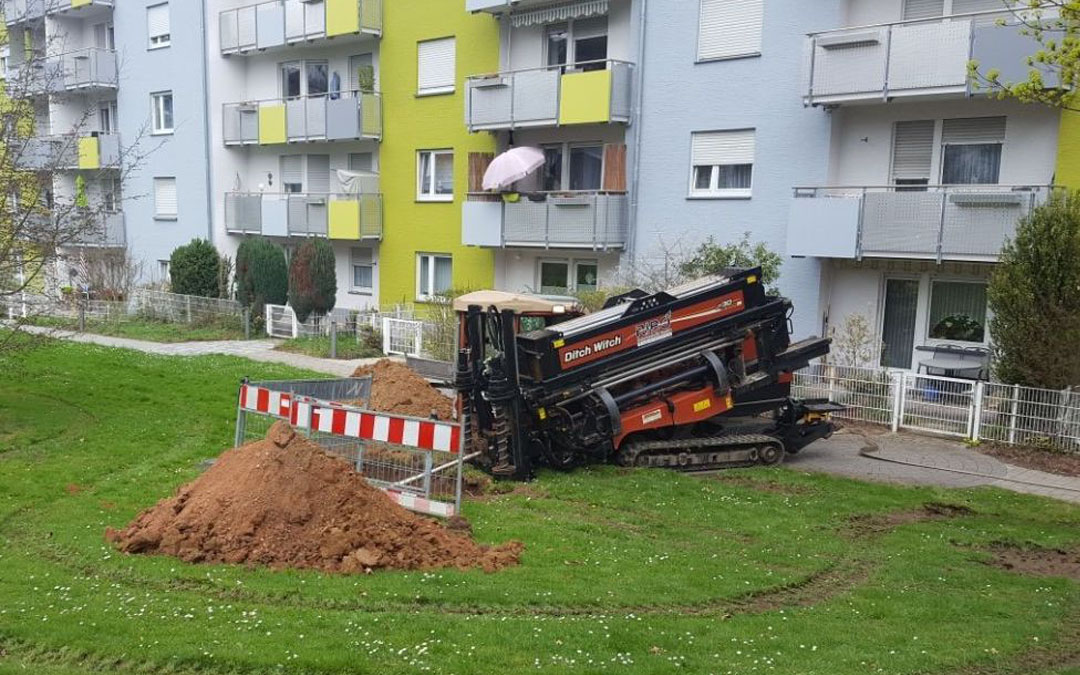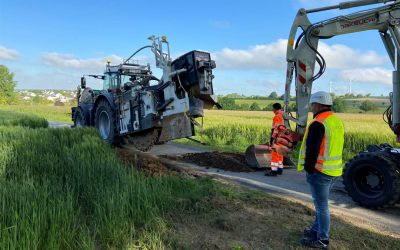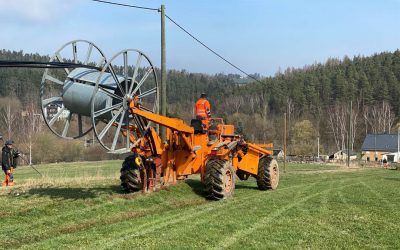Photo: IBZ Neubauer
When implementing broadband projects, different methods are used to lay the fibre optic cables. In contrast to “classic” civil engineering, in which an open trench is dug and the pipes are laid at least one meter deep, alternative laying techniques require less depth – and ideally almost no large excavation pit(s). Modern methods also save time and, not least, money.
Our new series “Alternative installation methods” introduces you to various alternative installation techniques, shows the advantages and disadvantages of the individual variants and names specific application scenarios. In the first part of our “Alternative installation methods” series, you will learn interesting facts about the flush drilling method. This alternative installation technique uses a drill head that digs through the ground and then pulls in the empty conduits to be laid. The flush drilling method is often used when crossing under obstacles such as railroad lines, roads or rivers.
The expansion of fibre optics in Germany is progressing at full speed – especially since the revision of the federal broadband funding programme in 2018, since which only pure fibre optic connections have been funded and the process has been considerably simplified. Even the coronavirus pandemic has done little to change this so far: In the meantime, most players have found individual and innovative solutions with which the gigabit expansion continues to be driven forward with commitment. Alternative laying techniques also play an important role here, replacing “traditional” underground construction, in which cables are laid at a depth of one meter or more. The use of innovative laying techniques can save time and money – because civil engineering costs are by far the most expensive component (up to 90 percent) of fibre optic expansion. One of these laying techniques is Horizontal Directional Drilling (HDD), usually simply referred to as “flush drilling”. Not only does everyone involved work under high pressure, but the actual installation also works according to this principle: a special drilling fluid (“drilling suspension”) flows at high pressure from the drill head equipped with nozzles, loosens the soil and stones and removes the mud and debris from the borehole.

Photos: Ludwigslust-Parchim district
This so-called drilling fluid also stabilises the drill channel so that it can no longer collapse. The fluid used consists of water mixed with bentonite, a clay mineral, and other additives. As the flush drilling method runs completely underground from the starting point to the target point (“trenchless”), it is mainly used where open excavation is not possible or would be uneconomical. This applies, for example, when crossing obstacles (e.g. railroad lines or rivers) or when passing surfaces that are particularly worthy of protection, such as in nature reserves. Rocky ground is not an obstacle – in this case, a special drill head is simply used. Flush drilling can be used to bridge distances from a few meters to several hundred meters. The flush drilling method is also particularly suitable for laying the optical fibre from the sidewalk to the cellar of the house to be connected: the front garden remains completely untouched; the drilling is completely invisible up to the cellar wall. However, before starting a flush drilling operation, it must be known which other lines/infrastructure have been laid underground in the past so that they are not damaged during drilling. For this reason, the planners must first obtain a precise overview of the specific situation on site.
Our “Alternative installation methods” series
DIN 18220 comes into effect – Alternative installation methods standardized
DIN 18220 comes into force on July 28. The full name of the standard is "DIN 18220:2023-08. Trenching, milling and ploughing methods for laying empty conduit infrastructures and fiber optic cables for telecommunications networks" and describes in detail the methods...
Classic and alternative installation methods
In order to enable the expansion of fiber optic networks throughout Germany, the players involved have a variety of installation methods at their disposal. The methods must be selected according to topological characteristics and special project requirements. Each...
Robots lay fiber optics in the sewer
An employee prepares the robot for use. Between 100 and 250 meters of fibre optic cable can be laid in this way per day. (Source: Fast Opti-com) Laying fiber optic cables in sewage pipes using robots is one of the alternative installation methods. These offer many...
DIN 18220 comes into effect – Alternative installation methods standardized
DIN 18220 comes into force on July 28. The full name of the standard is "DIN 18220:2023-08. Trenching, milling and ploughing methods for laying empty conduit infrastructures and fiber optic cables for telecommunications networks" and describes in detail the methods...
Classic and alternative installation methods
In order to enable the expansion of fiber optic networks throughout Germany, the players involved have a variety of installation methods at their disposal. The methods must be selected according to topological characteristics and special project requirements. Each...
Robots lay fiber optics in the sewer
An employee prepares the robot for use. Between 100 and 250 meters of fibre optic cable can be laid in this way per day. (Source: Fast Opti-com) Laying fiber optic cables in sewage pipes using robots is one of the alternative installation methods. These offer many...
Using traditional technology for a future-proof broadband connection: the plowing method as an alternative laying technique
The cable plow in use on a field. At the top left is the empty conduit, which is unwound from the drum and then laid in the freshly plowed furrow Photo: IBZ Neubauer When implementing broadband projects, different methods are used to lay the fiber optic cables. In...





